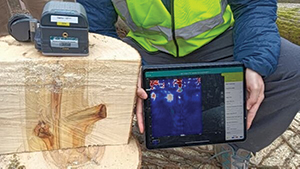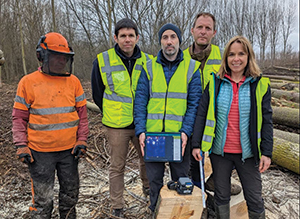Proceq GPR technology used for experimental research on non-destructive detection of wood quality
08/04/2025
Screening Eagle’s Proceq GP8800 ground-penetrating radar (GPR) has been selected for use in an experimental research project for the non-destructive detection of wood quality in poplar plantations.
The project, led by the Documentation, Reconstruction and Analysis of Complex Objects and Natural Environments (DRACONES) research group of the University of León within the framework of the technological transformation of the forestry sector, and within the framework of the European DIGIS3 project and the Forestry and Wood Technology Centre (CETEMAS), aims to develop a Proof of Concept (PoC): ‘Mapping and detection of quality wood in poplar plantations’.
Development of this PoC is being carried out in the poplar groves of Villamor de Órbigo, León, Spain, and will culminate in May 2025. The initiative seeks to transfer advanced tools for mapping and detecting wood quality to processing companies, with the aim of optimising processes and promoting sustainability within the scope of ‘smart forestry’.
Commissioned by the company Fustek, the project aims to integrate cutting-edge technologies, such as advanced sensors and digital twins, to detect the existence and depth of knots or cavities in standing trees, which depreciate the value of poplar wood and affect its industrial potential. Screening Eagle Proceq is providing GPR technology to detect non-visible internal variations in the wood. The DRACONES research group is contributing to the creation of digital twins through portable laser scanners, while CETEMAS uses resistographs to identify internal discontinuities in wood, such as knots and cavities.
 | ||
| The project aims to integrate cutting-edge technologies to detect the existence and depth of knots or cavities in standing trees |
The collaboration between institutions and companies, including a partnership with the Asturias Digital Innovation Hub (AsDIH), ensures a multi-disciplinary and practical approach. This reinforces digitalisation in the sector by promoting the use of non-destructive tools that generate accurate data, essential for more efficient and sustainable forest management. The work plan stages include design, calibration, analysis of results and the final presentation to the company. This structured approach ensures rigorous technical validation and effective transfer of the knowledge generated.
An official case study will be developed at the end of the experiment but, in the meantime, the ongoing research with the Proceq GP8800 stands as a powerful testament to the potential of GPR in modern forestry.
 | ||
| The University of León’s research group DRACONES is developing the PoC with collaboration from CETEMAS and Screening Eagle Proceq |
By seamlessly integrating advanced technologies, this project paves the way for a future where precise, non-destructive wood quality assessment becomes standard practice. This not only promises to optimise resource utilisation and enhance the economic viability of the forestry sector, but also underscores a commitment to sustainable management, ensuring the long-term health and productivity of our vital forest ecosystems.
The insights gained from this pioneering research will undoubtedly serve as a blueprint for future advancements, driving innovation and fostering a more resilient and digitally empowered forestry industry.
Screening Eagle Technologies provides a technology platform for intelligent inspection of the built environment. The company was created through the merger of Dreamlab in Singapore and Proceq in Switzerland with a mission to protect the built world with software, sensors and data.